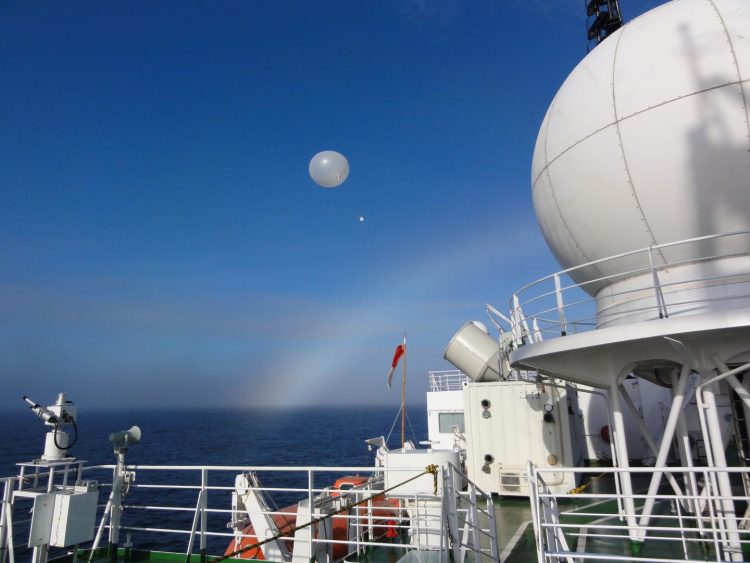Optimized arctic observations for improving weather forecast in the northern sea route

Figure 1. Radiosonde observations from RV Mirai over the ice-free Arctic Ocean. Credit: Jun Inoue
In September 2013, Dr. Jun Inoue from the National Institute of Polar Research (NIPR), Japan, and his international research team conducted joint Arctic atmospheric observations using radiosondes (instruments carried into the atmosphere by weather balloons, which measure various atmospheric parameters:Figure 1) on the research vessel Mirai and at meteorological stations surrounding the Arctic Ocean (Ny-Alesund, Alert, and Eureka).
The team launched radiosondes eight times a day from RV Mirai (operated by NIPR and the Japan Agency for Marine-Earth Science and Technology (JAMSTEC)), six times a day from Ny-Alesund (operated by the Alfred Wegener Institute), and four times a day from Alert and Eureka (operated by Environment Canada). Their high daily observing frequency improved the accuracy of atmospheric data used to estimate the state of the climate and weather forecasts because much of the observed data were incorporated into the initial conditions of the weather simulations in real time.
To investigate the impact of these special observations on the weather forecasts over the Arctic, the research team focused on a high-pressure system along the NSR on September 20, 2013 that caused strong coastal winds and rapid wind-driven sea-ice drift over the NSR. They incorporated multiple observations into the initial conditions of the weather simulations, including these special data and conducted ensemble forecasting experiments with an atmospheric general circulation model.
The influence of the special observational data on the predictability of the high-pressure system was then tested using the different initial fields by excluding these special data from each station separately. It was found that the uncertainty in the modeled wind fields associated with the high-pressure system was reduced when all the radiosonde data was included.
In particular, the data from Ny-Alesund and RV Mirai were very important for predicting this event, partly because of the flow-dependent characteristics in the upper atmosphere. Based on several sets of sensitivity tests, they also determined that four launches per day, once every six hours, is the most cost-effective observing frequency.
Predicted surface wind fields are usually used in sea-ice forecast models as forcing data; therefore, the growth of errors in sea-ice forecasts heavily depends on the accuracy of the predicted wind fields. The research team ran an ice-ocean-coupled model to understand the impact of the accuracy of the predicted wind fields on sea-ice forecasts. It was found that sea-ice forecasts initialized by wind fields that included the special observations adequately predicted the rapid wind-driven sea-ice advection along the NSR.
The research team concluded that additional atmospheric observations would effectively predict not only severe weather phenomena over the Arctic Ocean but also sea-ice distribution influenced by atmospheric forcing. During the Year of Polar Prediction (YOPP), from mid-2017 to mid-2019, proposed by the World Weather Research Programme — Polar Prediction Project (WWRP — PPP), these types of observations and modeling activities will be accelerated within the international framework and could contribute to establishing a sustainable Arctic observing network.
###
Source:
National Institute of Polar Research (NIPR), Research Organization of Information and Systems Japan Agency for Marine-Earth Science and Technology (JAMSTEC)
Media Contact
All latest news from the category: Physics and Astronomy
This area deals with the fundamental laws and building blocks of nature and how they interact, the properties and the behavior of matter, and research into space and time and their structures.
innovations-report provides in-depth reports and articles on subjects such as astrophysics, laser technologies, nuclear, quantum, particle and solid-state physics, nanotechnologies, planetary research and findings (Mars, Venus) and developments related to the Hubble Telescope.
Newest articles

First-of-its-kind study uses remote sensing to monitor plastic debris in rivers and lakes
Remote sensing creates a cost-effective solution to monitoring plastic pollution. A first-of-its-kind study from researchers at the University of Minnesota Twin Cities shows how remote sensing can help monitor and…

Laser-based artificial neuron mimics nerve cell functions at lightning speed
With a processing speed a billion times faster than nature, chip-based laser neuron could help advance AI tasks such as pattern recognition and sequence prediction. Researchers have developed a laser-based…

Optimising the processing of plastic waste
Just one look in the yellow bin reveals a colourful jumble of different types of plastic. However, the purer and more uniform plastic waste is, the easier it is to…


